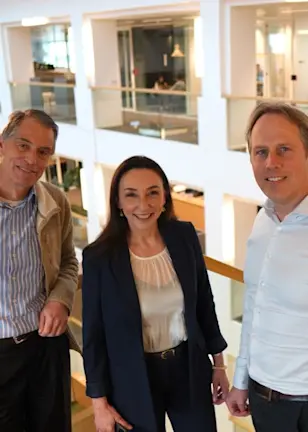The coming power surge
Electricity demand has been remarkably stable over the last two decades. However, the electrification of the economy and intensifying processing in data centers, are driving demand unexpectedly higher (see Figure 1). In Ireland data centers already gobble up more than 22% of total electricity and that’s expected to inflate to a third in just a few short years.1
In Asia, Malaysia is planning to increase data capacity ten-fold through 2026 in a bid to become a critical digital hub, a move that will intensify electricity consumption by up to 128%.2,3 The IEA predicts that by 2026 global data centers will consume as much energy annually as the entire country of Japan. After years of incremental growth, by the end of the decade, global data center power demand is poised to expand around 15% annually.4
Figure 1 – Data centers’ share of grid power is rising globally

Source: IEA, 2023. Data center energy demands are consuming more grid resources globally.
Utilities and network operators now face higher electricity demand while also combating aging and unpredictable grids (see Figure 2). Grids in countries globally are in desperate need of an overhaul as energy generation moves from dispatchable units from centralized power plants to intermittent ones from decentralized renewable sites. The majority of distribution lines are more than twenty years old in industrialized countries.
“
The majority of distribution lines are more than twenty years old in industrialized countries
Figure 2 – Aging grids are old and ill-equipped for next-generation electricity demand

Source: IEA, October 2023. The graphic shows the age of different parts of the energy grid. Transmission infrastructure (Tx) carries power from generation plants. Distribution infrastructure (Dx) is the last mile to end users.
The race for energy
The growth surge significantly resets the dynamics of power consumption trends, with implications for data centers and power supply chains globally. Big Tech players are feverish to establish an early foothold in AI’s game-changing potential. But that means building more data centers filled with cutting-edge GPU chips which need up to five times more electricity than CPU chips used for traditional data center processing.5
Mark Zuckerberg summed up the problem when he said, “energy, not compute, will be the number one bottleneck to AI progress.” A major concern around the highly anticipated growth in data center computing capacity is the availability of grid connections. Key issues include limited power lines, substations, and voltage transformers as well as delays in planning and permitting. Lead times for power projects are typically over five years in some regions in Europe and the US.
Sustainable energy
“
Energy, not compute, will be the number one bottleneck to AI progress.” – M. Zuckerberg
This is a race for energy. A recent study from Morgan Stanley showed operators would double the price they would pay local operators for electricity in order to gain access ahead of competitors. These scenarios are playing out globally and the press for power is reflected in Nvidia* CEO’s prophetic analysis that many nations will push to build their own “sovereign” AI systems to stay competitive and process data locally.
“
Many nations will push to build their own ‘sovereign’ AI systems to stay competitive and process data locally
Capacity constraints and climate goals challenge grids
Net-zero goals complicate the plot further. Governments and companies have pledged to decarbonize by 2050 which limits power generation to low-carbon energy sources. Solar is seen as clean and is quickly built relative to other energy source. A solar farm can be built in less than a year, compared to nearly six years for nuclear (see Figure 3).
Figure 3 – Construction time needed for energy sources (in months, expected megawatts of power)

Source: Lazard, 2021. EIA, 2022.
Moreover, even if enough renewable sites could be built, intermittency of power production and fragmentation of power distribution across remote sites make renewables unsuitable for providing steady baseline power needed by not only data centers but the entire grid.
As a result, utilities are combining renewables with natural gas generation to balance long-term transition goals with short-term demands (see Figure 4). The large number of renewable project applications reaching late-stage connection-studies with grid operators testifies to the strong interest of developers. While not all of these projects are guaranteed connections, the high levels of new capacity from those that do connect will further strain transmission capacity.
Figure 4 – Renewable interest is exploding, pressuring grid stability

How does this impact Smart Energy investments?
We view the coming AI race as a multi-year trend with broad-based investment opportunities across industrials, technology, renewables and utilities.
Electrical grid equipment providers are among the first positively impacted segments, with global annual electrical grid capex expected to grow at 8% CAGR from 2022 to 2032. Within this group, one of the most promising industries are high-voltage cable manufacturers. These so-called ‘interconnectors’ carry electricity over long distances (including between countries) with minimal losses. They are also better suited to manage energy from different sources which helps maintain synchronicity across different networks.
Energy-efficiency of end-use equipment is also a key solution. Cooling is already emerging as the biggest opportunity for making data centers more energy efficient. GPU chips used for AI are heat-intensive and tightly packed by the tens of thousands into hyperscalers. Newer liquid-based solutions such as direct-to-chip cooling (DTC) offer huge energy savings compared to traditional air cooling.6
And while less than 25% of data centers currently use low-carbon energy, pressure from regulators makes renewable power generation mission critical and are driving investments across the energy value chain. And the biggest data center customers – Amazon, Meta, Microsoft and Google* – are already leading by example. All have set ambitious climate goals in the near and long term so it’s unsurprising that they also are the largest corporate purchasers of renewables from utilities and network operators.
* The Robeco Smart Energy strategy is not invested in any of the stocks listed, nor should these references be considered as recommendations to buy, sell, or hold these or any securities.
Footnotes
1Financial Times. February 2024. ‘Data centres curbed as pressure grows on electricity grids.’
2Ten-fold data center increase through 2026, Bloomberg, June 2024. ‘AI is already wreaking havoc on global power systems.’
3Electricity consumption growth calculated from a base year of 2022 through 2026, Malaysian Investment Development Authority, April 2024. ‘Data centres, AI initiatives to boost electricity demand.’
4Annual growth in CAGR, Goldman Sachs, April 2024. ‘Generational growth in AI data centers and the coming US power surge.’
5Robeco, November 2023. ‘The energy challenge of powering AI chips.’
6Air based cooling consumes on average 40% of a data centers’ total electricity.
重要事項
当資料は情報提供を目的として、Robeco Institutional Asset Management B.V.が作成した英文資料、もしくはその英文資料をロベコ・ジャパン株式会社が翻訳したものです。資料中の個別の金融商品の売買の勧誘や推奨等を目的とするものではありません。記載された情報は十分信頼できるものであると考えておりますが、その正確性、完全性を保証するものではありません。意見や見通しはあくまで作成日における弊社の判断に基づくものであり、今後予告なしに変更されることがあります。運用状況、市場動向、意見等は、過去の一時点あるいは過去の一定期間についてのものであり、過去の実績は将来の運用成果を保証または示唆するものではありません。また、記載された投資方針・戦略等は全ての投資家の皆様に適合するとは限りません。当資料は法律、税務、会計面での助言の提供を意図するものではありません。 ご契約に際しては、必要に応じ専門家にご相談の上、最終的なご判断はお客様ご自身でなさるようお願い致します。 運用を行う資産の評価額は、組入有価証券等の価格、金融市場の相場や金利等の変動、及び組入有価証券の発行体の財務状況による信用力等の影響を受けて変動します。また、外貨建資産に投資する場合は為替変動の影響も受けます。運用によって生じた損益は、全て投資家の皆様に帰属します。したがって投資元本や一定の運用成果が保証されているものではなく、投資元本を上回る損失を被ることがあります。弊社が行う金融商品取引業に係る手数料または報酬は、締結される契約の種類や契約資産額により異なるため、当資料において記載せず別途ご提示させて頂く場合があります。具体的な手数料または報酬の金額・計算方法につきましては弊社担当者へお問合せください。 当資料及び記載されている情報、商品に関する権利は弊社に帰属します。したがって、弊社の書面による同意なくしてその全部もしくは一部を複製またはその他の方法で配布することはご遠慮ください。 商号等: ロベコ・ジャパン株式会社 金融商品取引業者 関東財務局長(金商)第2780号 加入協会: 一般社団法人 日本投資顧問業協会


















